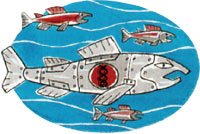
Illustration: Thorina Rose
The furor over potential risks to health and the environment from genetically engineered (GE) corn, soybeans, and other crops may be years away from dying down. But now, the biotech industry seems set to begin serving up an entire new menu of GE foodstuffs, this time with mobility, instincts, circulatory systems, and, just maybe, the ability to breed of their own volition: genetically engineered food animals.
Sometime this year, federal regulators could approve a proposal by a Waltham, Massachusetts-based company called Aqua Bounty Farms to begin marketing millions of glistening orange salmon eggs laced with dna from the ocean pout, another fish species. The company promises fish farmers that the bit of new genetic code will trigger salmon hatchlings to produce growth hormones throughout their first year, rather than just during the warm months, as they naturally do. The result: salmon that reach market size in 18 months, rather than the usual 36. If federal regulators give the green light, GE salmon filets could begin showing up on supermarket shelves in time for the 2002 holiday season.
The Aqua Bounty request promises to be one of the first in an eventual cascade of petitions for approvals of other GE animals. The company is working on fast-growing tilapia and trout. Others have begun research on developing pigs with leaner meat, disease-resistant chickens and turkeys, and even honeybees inured to pesticides. But it is the prospect of genetically engineered fish that particularly alarms some critics, who point out that the world has already had abundant experience with genetically foreign species introduced to ecosystems. Across the United States, kudzu and purple loosestrife are crowding out native plants; zebra mussels are gorging on the native plankton food supply of the Great Lakes; and the Asian long-horned beetle is devouring trees in New York and Chicago. In 1999, scientists at Purdue University reported that GE salmon could turn into a similar ecological nightmare if they escaped from pens and bred with wild Atlantic salmon stocks.
But despite the ecological concerns, none of the U.S. government’s environmental agencies — the Environmental Protection Agency, the Fish and Wildlife Service, or the National Marine Fisheries Service — has taken the lead role in deciding whether GE fish should be approved. Instead, responsibility for regulating Aqua Bounty’s innovative salmon, as well as a similar project in Alabama involving genetically engineered catfish, has been put in the hands of the U.S. Food and Drug Administration’s Center for Veterinary Medicine. The agency reasons that the growth-promoting gene inserted into the salmon is analogous to a drug and should be regulated as such.
In the past, critics have blasted the FDA for its apparently cozy relationship with the biotech food industry (“Pandora’s Pantry,” January/February 2000). Now there’s another problem, says Rebecca Goldburg, a senior scientist at Environmental Defense (formerly the Environmental Defense Fund): The agency lacks scientific credibility on matters of wildlife and ecosystems. “Having the FDA assess environmental risks,” Goldburg argues, “would be like having the Fish and Wildlife Service assessing food safety.”
A key problem, according to Goldburg and other skeptics, is that the notion of genetically altering a wild, native animal and raising it on farms is so novel that neither Congress nor the regulatory agencies have devoted much attention to it. Indeed, last year Edwin Rhodes, aquaculture coordinator at the National Marine Fisheries Service, expressed surprise when a reporter told him that the GE salmon was being evaluated exclusively by the FDA. (Last May, the Clinton administration initiated a review of federal laws covering transgenic organisms; a draft was slated for completion early this year.)
Now, Rhodes says, FDA ecologists will be consulting with his agency and other environmental regulators to determine “how exactly to divide responsibilities and collaborate.” But that, maintains Jane Rissler, a biotech foods expert with the Union of Concerned Scientists, still leaves the matter in the hands of an agency that is “ill prepared” for the task. “The FDA focuses on health risks,” she concludes. “They simply do not have expertise in this area.”












